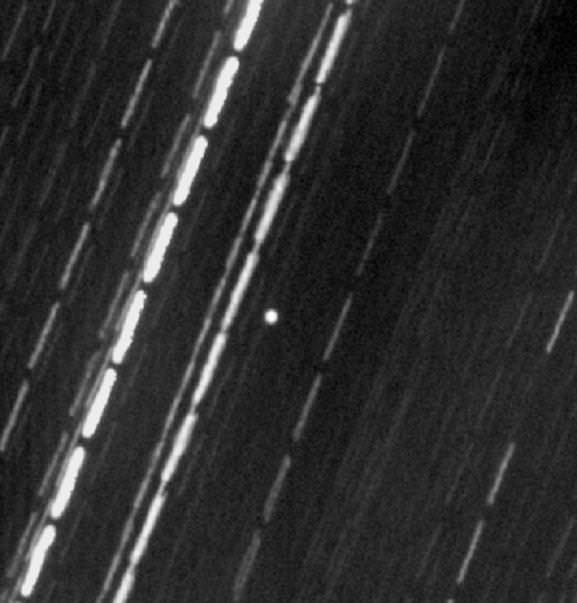[/caption]
Is the recently discovered “winking” asteroid – GP59 – really the missing panel from the ill-fated Apollo 13 mission? According to the latest internet buzz, it could be as possible as Mars being as large as the full Moon…
With the recent anniversary of the Apollo 13 disaster conveniently coinciding with the discovery of “winking” near-Earth asteroid GP59, anxious theorists are ready to believe they are one and the same. Thanks to the asteroid’s rapid tumble and quick magnitude changes, it’s no small wonder that it would appear on the surface to be so. Just take a look at this GP59 Video done by Joe Brimacombe and you’ll see why.
With discoveries of artifacts continually found on Earth, such as missing pieces of the Titanic, it wouldn’t take a great leap of faith to believe we might have recovered one in space as well – even the panel that blew away from Apollo 13. However, we need to take a look at that equation times four – the 4 panels that protected the LM during launch – the Spacecraft Lunar Module Adapter (SLA) panels. Says Marshall Eubanks, ” In the Saturn V launches, the SLA panels were ejected, with separation velocity of about 2 meters / second. They were 6.4 meters tall, about 3 meters wide at the apex, made of a 0.043 meters thick aluminum honeycomb, plus about 1 mm of cork and paint, and so have a very low mass-area ratio. If 2011 GP59 is an SLA panel, then it should have 3 clones with very similar orbits.”
With today’s huge advances in amateur telescopes, there remains a possiblity – however small – that we may someday recover objects like these. “I could see a situation in which a panel was spinning around its short axis, with that axis tilted a bit toward the Sun, so that there would be a systematic pressure accelerating or decelerating it. (Sort of like what the fans of spin-stabilized solar sails hope to do.) The problem would be that over a full orbit around the Sun, the net acceleration would cancel out.” says Bill Gray. “The bottom line remains: there is no particularly good reason to think there’s a connection between these panels and 2011 GP59. (Even if the panels were big enough to match the observed brightness of 2011 GP59, which they aren’t.) If the panels are ever recovered, they’re apt to be in much more Earth-like orbits. With 36 of them out there, the odds seem decent that we’ll see one of them someday.”
But don’t hold your breath when it comes to GP59… it is what it is… a tumbling, oblong asteroid roughly 47 meters in diameter. “Usually, when we see an asteroid strobe on and off like that, it means that the body is elongated and we are viewing it broadside along its long axis first, and then on its narrow end as it rotates ,” said Don Yeomans, manager of NASA’s Near-Earth Object Program Office at the Jet Propulsion Laboratory in Pasadena, Calif. “GP59 is approximately 50 meters [240 feet] long, and we think its period of rotation is about seven-and-a-half minutes. This makes the object’s brightness change every four minutes or so.”
And our hearts skip a beat just thinking of the possiblities…


I’m guessing the over-imaginative theorists you speak of probably think the panel is from the side of the Apollo spacecraft, instead of one of the four adapter panels. Otherwise, why specifically Apollo 13?
bring back the old bad astronomy! That’s show the conspiracy theorists! Also, if it can’t be distinguished as even something as vague as an object of terrestrial origin, then why speculate about a VERY specific part, of many hundreds of pieces of debris left by various missions?
If I’m not mistaken, an entire Saturn SIV-B upper stage (from a Lunar mission before they were directed to impact the Moon) was similarly discovered, and found to be ‘one of ours’ and not a natural NEO, when its reflectance spectra was found to be consistent with titanium dioxide…white paint.
Strange story…
Its very surprise but i think we cant see it with our naked eye.